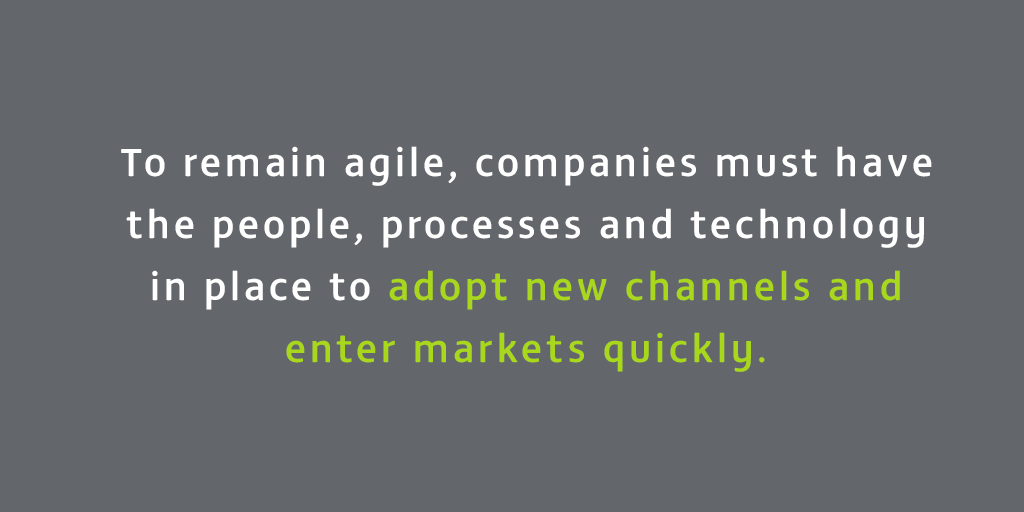Three trends utilities companies must nail in the next five years
Written by Robyn Jones
Across the sector, companies are failing to keep pace with the experiences offered by digital pioneers such as Amazon, Netflix and Uber, who continue to shape customer expectations across the board. This evolution is hastened by Ofwat’s latest price review (PR19) and Ofgem’s current and looming price control framework (RIIO / RIIO-2), both of which are calling for utilities providers to drive innovation and plan for the long term.
Today, nearly three quarters of Europe’s utilities providers claim to offer mobile payment, and 59% state that they provide a fully remote connect/disconnect service. While over half of companies provide mobile usage tracking, and 46% supply smart meters (CXP Group, 2017).

The signs are encouraging. In the UK, First Utility (recently bought by Shell) has incorporated Facebook Messenger into its customer engagement channels, managing an average of 70 conversations a day with a response time of 3.5 minutes. The company also uses AI-powered virtual assistants under its ‘Ask First’ platform.
While in the water sector, United Utilities has introduced intelligent search, which understands customer intent and connects customers to more accurate answers, faster.
Providers are looking to establish a foothold in the smart home space, with several partnering with technology start-ups. For example, EDF’s Blue Lab worked alongside Intelesant Ltd to trial its Howz smart home product, which monitors how much electricity is being used and when, while Centrica-owned British Gas has acquired AlertMe, the technology platform that underpins connected home brand, Hive.
As customer experience evolves, we look at three key areas on which utilities providers must focus over the next five years if they are to compete and thrive…
1. Advanced personalisation
From Amazon and Netflix using algorithms to personalise a customer’s homepage, and show recommendations based on an individual’s viewing habits, to Adidas creating shoes tailored to each customer’s foot, personalisation is here to stay.
A recent Salesforce study showed that 52% of consumers would move away from brands that don’t personalise communications, while 65% say that personalisation influences brand loyalty.
In every industry, the concept of personalisation will become more prevalent as the technologies that accelerate it mature, and the data that is needed to feed it becomes more structured and accessible. In return for their valuable data - and their loyalty - customers will increasingly expect their providers to treat them individually across all channels, not only catering for their needs, but predicting them as well.
Netflix continues to shape expectations…
Netflix is one company that has raised the bar. It estimates that 80% of content consumed comes from recommendations informed by data, with hyper-personalisation resulting in less subscriber churn, more content consumed, and stronger customer relationships. Netflix also claims that using artificial intelligence to make personalised recommendations - and therefore automating the process - saves the company US $1bn a year.
People are coming to expect the same level of personalised service in every industry - including the utilities sector.
Customers will increasingly expect pre-emptive messages concerning an interruption to their water supply, or tailored advice regarding their electricity usage, for example. They will also demand more and more sophisticated self-service, with real-time access to their usage and personalised tips on where savings can be made.
Driving behavioural change
As Alyssa Farrell, Product Marketing Manager, Energy and Sustainability at SAS says, such data can enable energy providers to highlight efficiency savings as well as enticing customers with rewards to change their behaviour.
“For example, it will be possible to provide insights about the efficiency of major appliances and lighting in the home just by analysing changes in electric current. Analysing this data will help households take energy-saving measures with short and long term financial gains. Maybe you can even forecast the impact on your quarterly energy bill by taking advantage of an offer, via an app on your smartphone.”
Such innovations enhance the customer experience at the same time as reducing utilities providers’ cost to serve. Done well, personalisation can drive positive, more economical behaviour, as well as managing customer costs - a key thrust of both PR19 and RIIO - by offering timely advice or solutions.
Within the next five years, personalisation will become far more sophisticated. The data that companies gather from multiple channels will allow them to provide everything from money saving tips to dynamic offers targeted directly at the individual.
2. Channel hopping
There is no longer such a thing as a ‘typical’ customer journey. We research products on our tablets, buy them on our laptops, then tell our friends about it using our smartphones. We stream TV programmes on our tablet, pause them, then continue to watch on our smartphone. Channel hopping is just the way people roll, and consumers expect to be able to do it whenever they want.
As channels continue to emerge - from wearable technology to Virtual Reality and voice activated virtual assistants - every industry must be ready to adapt, and be able to serve its customers on the channel of their choice.
Campbell Soup embraced Alexa
Campbell Soup brand is a great example of an early adopter. It was among the first food companies to use Alexa voice technology to launch a skill in 2015, attracting more than 50,000 unique sign-ups and suggesting more than 174,000 recipes by July 2017. It was also one of the first brands to offer a visually enabled skill on Amazon’s new Echo Show touchscreen device, launched in late 2017.
Virtual assistants have also prompted action in utilities, with British Gas’ bundled Hive and npower’s Nest both developing skills that allow users to adjust home appliances using voice activation.
Channel integration is essential
It isn’t just about being where your customers are. Companies must also be poised to integrate new and emerging channels with existing ones to ensure a seamless experience. In utilities, this might mean bringing together data from smart meters, virtual assistants, social media and chatbots, to achieve the much sought after Single Customer View. A holistic view also enables companies to identify actionable insights, and find opportunities to add value or up-sell.
To remain agile, companies must have the people, processes and technology in place to adopt these new channels and enter markets quickly. Establishing the right platform early on is critical, enabling companies to create content once, and publish it across multiple channels, in the right context, at the right time.

3. Operational ownership
Demand on the traditional utilities infrastructure is increasing, while consumer expectations continue to rise and bad debt remains a significant problem. Putting customers in control of their consumption and incentivising them to work with providers to manage supply and demand will play a big part in addressing these challenges.
Open banking has sparked ideas
Other industries are forging ahead in this area, and utilities are likely to follow suit. For example, in the financial services sector, ‘open banking’ now means that UK-regulated banks are obliged to give customers control over their financial data, allowing them to share it with third parties. It means banking will no longer be siloed in one app or website.
This move is designed to encourage more competition and innovation, whereby improving customer experience. For example, customers could sign up to a provider which displays all of their bank accounts in one place. Elsewhere, in fintech, Bud is working with HSBC to build an app that will scan customer accounts to make sure individuals are on the best phone and energy tariffs.
As Imran Gulamhuseinwala, Head of Fintech at EY, and implementation trustee of Open Banking Limited, says, “[There] is no reason why this couldn't be rolled out into the mobile phone and telco space, why it couldn't be rolled out into energy, water and, to some extent, into transport as well.”
Utilities: “Ripe for revolution”
The idea of customers managing all of their utilities through a single interface is one that has been widely mooted, not least by former Ofwat CEO, Cathryn Ross, who envisaged specialist companies using data analysis to better understand customers’ needs and priorities to find the best combination of services at the right price.
“Imagine a world in which you don’t even know who your supplier of water and waste water services is, or who supplies your energy, or broadband, or maybe even your home insurance and emergency cover,” says Ross. “Because you have a contract with an intermediary who takes care of all that for you.
“You may well have given them the ability to turn some bits of your home infrastructure on and off to manage demand and reduce costs, because this will enable you to get a cheaper deal. To my mind this means the water sector, indeed all utilities, are ripe for a revolution.”
The future of CX in utilities
Customer experience is changing and, driven by PR19 and RII0, utilities companies are under arguably greater pressure than other sectors to innovate and deliver. But while there are a host of significant challenges threatening to slow down the progress of utilities companies, there are plenty of opportunities that will drive positive changes across the sector.
Parts of this article were originally published in Water Industry Journal.
What else is going on
-
March 2024
Ghost Spam in GA4 – How to Spot and Deal With It
How to spot and deal with ghost spam in Google Analytics 4 (GA4) to safeguard your data insights. Implement proactive measures to maintain data accuracy.
-
November 2023
Mando to bridge skills gap at BIMA Digital Day
The BIMA Digital Day on November 8th is an attempt to bridge this skills gap, as eight of Mando's experts will spend time with around 240 Year 10 students from The Studio School at their Liverpool campus.



